| Kurgan Culture Contents | |
|
Why Pazyryk? A look at Kurgans 1. Pazyryk mtDNA Genetics - M.I.Voevoda 2. Pazyryk mtDNA Genetics - I.V.Kulikov Pazyryk Craniology - Tur S.S. |
Pazyryk Timing - L.S. Marsadolov 14C Euroasian Timing 3,000 BC-50 AD - A.Yu.Alekseev et. al. Modern Türks of Pazyryk Descend - Tur S.S. |
Modern Türks of Pazyryk Descend
Posting Foreword
Pazyryk Kurgan 6, Rudenko1956
Rudenko S.I. "Culture of Mountain Altai population in Scythian times", Moscow-Leningrad, USSR Academy of Sciences Publishing, 1953.
http://eps.dvo.ru/rap/2006/4/pdf/rap-111-115.pdf
Trident tamga still shows up in the coat-of-arms of Ukraine, Moldova, and Tatarstan.
Elsewhere, trident tamga was a royal tamga of Kushans, and is depicted on East European nomadic artifacts and coins.
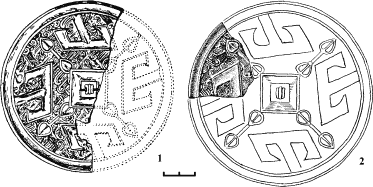
Scytho-Siberian Mt DNA persistence
among population of Altai and populations from Kazakhstan to China
From Pre-Iron, Iron, Late Iron times to the present day
Mt DNA A, B, F, J, H/U/HV, I, K, N, T, U5, W
Ricaut FX, Keyser-Tracqui C, Bourgeois J, Crubézy E, Ludes B.
Hum Biol. 2004 Feb;76(1):109-25, Genetic analysis of a Scytho-Siberian skeleton and its implications for ancient Central Asian
migrations
http://www.ncbi.nlm.nih.gov/pubmed/15222683
109-25Fig3.gif)
Okunev Culture of the 1-st half of the 2-nd millennium BC in Minusinsk depression. They are ccontemporaries and possibly successors of Afanasiev Culture of metallurgists and cattlemen of the 3-rd - beginning of the 2-nd millenium BC. Morphologically Okunevs are Uraloids.
Uralic race (aka Ugro-Yeniseian, Western Siberian race) consist of several anthropological types: Lapanoid, Sub-Lapanoid, Sub-Uralic, Uralic. Typical is a combination of Caucasian and Northern Asian (Northern Mongoloid) race attributes. Characteristic features: gracile constitution, relatively low flattened face, frequently concave noseridge, relatively light for the Mongoloids pigmentation of hair and eyes, hair wavy, soft, thin lips (most of these attributes, italicized here in this citation from a Russian Archeological Encyclopedia, archeologically do not exist, making everyone caught with a "gracile" constitution and "relatively" low flattened face an automatic half-Caucasoid Uralics). The Mongoloid-Caucasian gradient is very smooth and gradual, it is described by a number of intermediate types. Sometimes in the Uralic race is included Lapanoid type, or a little more Mongoloid Western Siberian type. The earliest anthropological finds, all undated, but typologically from the Neolithic - Eneolithic epoch, in the Ural territory belong to the Uralic race.
Caucasoid race (Europoid race, frequently disguised under "Indo-European" euphemism) survived only in the post-Soviet scientific nomenclature, but it is widely used outside of the scientific sphere. It never had a scientific definition, but is used instead as an intuitive concept excluding Mongoloids and Negroids, which in the Europoid great scheme includes all non-Europoids. The race is described separately by its sub-races, the color of skin remains a dominating but not an absolute parameter, and there is not a single parameter which is applied to all sub-races and distinguishes Caucasoids from "others" - Mongoloids and Negroids. To the Caucasoid race are ascribed a number of anthropological types: Nordic, Dinaric (Türkic), Mediterranean, Alpine, East Baltic, Turkish, Bedouin, Afganian, Dravidian. Apparently, S.S.Tur uses Debets' canonical technique to determine percent of admixture based on two questionable criteria. However, the measurements do not tell lies, deceptive can only be interpretations.
(Barnaul, 2003)
MODERN DESCENDANTS OF PAZYRYK CULTURE CARRIERS
http://e-lib.gasu.ru/da/archive/2003/10/14.html
The possible participation of Pazyryk culture carriers in formation of modern population of Western and Southern Siberia attracted attention for the first time in connection with the data of paleogenetics Comparative analysis of mitochondrial DNA from three Pazyryk mummies has shown that closest to them are the genes of the modern Selkups and Kets (Voevoda M.I., Romashchenko A.G., Sitnikova V.V., Shulgina E.O., Kobzev V.F., 2000, p. 91). However, historical interpretation of the established genetic affinity between the populations considerably removed from each other not only chronologically, but also territorially appeared difficult. The results of the molecular genetic analysis hypothetically can be explained by two reasons, a migration of the Pazyryks to the north, and their subsequent merging with ancient predecessors of Selkups, or a presence in the Pazyryks and Selkups a common component. To solve this dilemma within a framework of the molecular genetic analysis was not possible: the database for mitchondrial genom of the ancient and modern populations is extremely limited (Molodin V.I., etc., 2000, p. 64; Voevoda M.I., Sitnikova V.V., Romashchenko A.G., 2000, p. 224-230; Voevoda M.I., Romashchenko A.G., Sitnikova V.V., Shulgina E.O., Kobzev V.F., 2000, p. 88-94).
Better opportunities for finding the role of Pazyryks in the formation of the Western and Southern Siberia modern population give craniological materials. Craniological features of the ancient Pazyryks, and the modern peoples of the Western and Southern Siberia are studied well enough.
Population of the Pazyryk culture
Typical for the Pazyryks craniological complex of attributes has a certain similarity with the modern Southern Siberian race, but is more Europeoid(Chikisheva T.A., 2000à, p. 43). It is characterized by mezobrachicranial, average size cranium and by high, wide, medium flat face with medium protruding nose (Chikisheva T.A., 2000á, p. 110). This type existed in the territory of Altai Mountains during Bronze Epoch, as a result of mixture of two morphological types: dolichocranial Europeoid, with high and wide face,, and brachicranial, with moderately expressed Mongoloid features and low face. Occurrence in this region dolichocranial Europeoid type also called hypermorhpal Eastern Mediterranean, is linked with migration of cattle breeding tribes from Middle or Near Asia. A second craniological complex is found in the territory of Altai Mountains since an Eneolith Epoch (Lower Tytkesken -1 and Chimney caves) (Chikisheva T.A., 1996, p. 250-251; 2000á, p. 112). The ratio of initial components in different local groups of the Pazyryk population varies. The unmixed Europeoid type is more often in the Southwest areas (Barburgazy and Buguzuna valleys, plateau Ukok) and the Central Altai (Chikisheva T.A., 2000á, p 112). Densities of the brachicranial Mongoloid component with somewhat low face is higher among the population of the northern, peripheral parts of the Pazyryk area (Middle Katun) (Tur S.S., 1999, p. 203-205; 2002), whose culture has a number of distinctive features (Stepanova N.F., 2000, p 23), and also among Karakobins (Chikisheva T.A., Pozdnjaks lD.V., 2000, p. 128).
In the Pazyryk population, besides a main anthropological layer genetically connected to the Altai tribes of the previous epochs, shows one more, a Mongoloid type, with mezodolichocranial cranium and the high face, which can be named Paleosibirian. Inclusion of this component in the anthropology of Pazyryks, in T.A.Chikisheva's opinion, most likely occured as a result of their political relations with Mongoloid peoples of Eastern Siberia and Mongolia (Chikisheva T.A., 2000á, p. 113).
Modern peoples of Western and Southern Siberia
Anthropological classification of the and modern peoples has two intermediate racial groups, South Siberian and Western Siberian (former Uralian) with different formation mechanisms. If South Siberian results from long mixture of Europeoids and Mongoloids, the dominating factor in the formation of the Western Siberians, especially in the early stages, is autochtonial development and preservation of the protomorphal not differentiated features in the conditions of geographical isolation (Bagashev A.N., 1998, p. 318).
In the South Siberian group (with area not limited to the Siberian region) 4 anthropological types differ in the ratio of the Europeoid and Mongoloid components: Tian Shan (Chinese copy of the name Altai = Golden Mountains), Kazakhstan, Altai-Sayan and Northern Altai. In the first three dominates Mongoloid component, which densities decrease in the same sequence from Tian Shan to Altai-Sayan (Alekseev V.P., Gohman I.I., 1984, p 158). In the Northern Altai type dominates Europeoid component. The Mongoloid component in the South Siberian differs by a wide, high, flattened the face and has Central Asian origin (Bagashev A.N., 1998, p. 313). The Altai anthropological type, besides Northern Altaians (Kumandins, Tubalars (Tubalars is a taphtology, -lar is a Türkic plural suffix)), includes Bachat Teleuts, who in the historico-linguistic perspective are close with Southern Altaians, and also Mountain Shors. Altai-Sayan anthropological type unites Khakass groups (Kachins, Koybals, Beltirs, Sagays (Sakas) and Abakan Shors (Bagashev A.N., 1998, p. 233-234, 308, 313, 329). Southern Altaians (Telengits) also belong to them.
Peoples of Western Siberia with typical original combination of softened Mongoloid features with the low face belong to Western Siberian group. It has two anthropological types, differing in the form of the head, the Ural (dolichomezocranial) and Ob-Irtysh (brachicranialj). The Ural anthropological type, with the distribution area of northern part of the Western Siberia, includes Khants and Mansi. It has two local variants, the Ugrian area in the center, and Sub-Ugrian on the periphery. Ob - Irtysh anthropological type is located in the central and southern part of Western Siberia, it also has two local variations, Tomsk-Narym (Selkups, Chulyms, Tomsk Tatars) and Tobol-Irtysh (Tobol-Irtysh Tatars, early Barabin Tatars) (Bagashev A.N., 1998, p. 320-324).
Taksonomically, Nenets and Kets are outside Western Siberian (former Uralian) group, where they were usually included. They are an independent variant of the Northern Asian group of the Yenisei anthropological type, taksonomically equal to the Central Asian and Baikal types (Bagashev A.N., 1998, p. 326).
Similar to the dolichocranial Mongoloid complex with low face, inherent to the Ural anthropological type of the Western Siberian group, the brachicranial low faced Mongoloid complex, determinative for the Ob-Irtysh anthropological type, was typical for the Southern Taiga population of the Western Siberia as a minimum already during Bronze Epoch (Bagashev A.N., 2000à, with 250-251).
The specifics of the Northern Altai type that covers Northern Altaians, Teleuts and Mountain Shors, is such features as mezocranial cranium with higher arch and a narrow forehead, medium wide, relatively high medium flattened face and poorly articulated nose (Dremov V.A., Kim A.R., 1998, Tabl. 1-4). A similar morphotype can also be found outside the Altay region, in some late time local groups of the Barabin Tatars(Gjatsk, Kayly-Ugurmanka) (Kim A.R., 1998, Tabl. 14) and even among Bashkirs (Mavlütovo) (Üsupov R.M., 1989, p. 90). If the Northern Altaiy anthropological type is compared with the Pazyryk population craniological type (Chikisheva T.A., 2000á, p. 110), the distinctions between them mainly go in the direction of size reduction, and can be explained by epochal gracialization. The typical Northern Altaian population combination of the craniological attributes can be viewed as a modern modification of the Pazyryk craniological complex.
Òhe reason for the Pazyryks and Selkups molecular genetic affinity is a common component, which morphological specificity is determined by a combination of moderately expressed Mongoloid features with low (in the Mongoloid scale) face and brachicranial cranium. This genetic component was included in the Selkups and Pazyryks by independent processes. The Ob-Irtysh anthropological type represented by Selkups from the Southern Taiga population of the Bronze Epoch Western Siberia, and the Pazyryks inherited it from the population of Altai Mountains in the Eneolith Epoch.
A better objective estimate of the role of the Pazyryk culture carriers in the forming of the modern peoples can be received with the help of multivariate statistics methods.
[Follow detail descriptions and explanations of the multivariate statistics methods, results and graphs].
The main results of the statistical analysis are shown in the graphic form (Fig. 1-8).
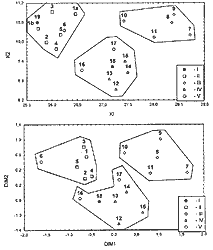 |
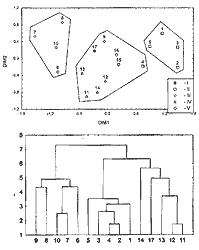 |
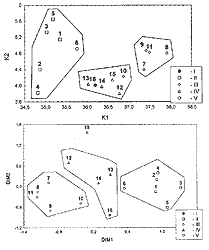 |
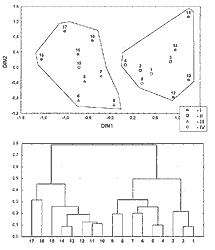 |
The results of the canonical analysis of the attribute variability and clustering and multivariate scaling of the taksonomical distances for the male craniological series unequivocally confirm a significant similarity of the "classical" Pazyryks craniological types and modern Northern Altaian populations: Kumandis, Teleuts, Tubalars and Mountain Shors (Fig. 1-2). The late time Barabin Tatars and Mavlütovo Bashkirs also belong to this cluster.
The other populations, according to their taksonomic position in the modern system (Bagashev A.N., 1998, p. 308-321), were divided between two others clusters: Altai-Sayan anthropological type of the South Siberian group and Ob-Irtysh anthropological type of the Western Siberian group. To the last of them also belong Kulais. The Kets received a dual status: the results of the analysis of attribute variability and taksonomic distances for this group diverge. Despite the abscence of close related links between Kets and the peoples of the Western Siberian group, common moments in the etnogenesis of both groups undoubtedly exist (Bagashev A.N., 1998, p. 326).
The late time Barabin Tatars belong to the Northern Altai cluster, and Beltirs are most closely connected with Altai-Sayan cluster. From the results of the cannonical analysis, both these groups besides a base component incorporate an admixture of low-faced Mongoloid type peculiar for the Ob-Irtysh populations.
The heterogeneity of the Khakass populations was noted by different researchers (Alekseev V.P., 1974, p. 199-204; Bagashev A.N., 1998, p. 308, 313). Their Altai-Sayan and Northern Altaiy types differ not only in the densities of the Europeoid component (Bagashev A.N., 1998, p. 313), but also in the character of the Mongoloid component.
The presence of morphogenetical continuity between the ancient carriers of the Pazyryk culture and the modern populations of the Northern Altai anthropological type is traced not only in the males, but also in the female lines (Fig. 5-6).
Comparison of Pazyryk's local groups with the modern representatives of the Northern Altai, Ob-Irtysh and Altai-Sayan types shows that the ratio of initial components, and also the intensity of mestication within the Pazyryk culture area varies. While the Pazyryks of the Kyzyl-Djar and valleys Üstyd, Chu, Ulandryk do not show any essential differences from the modern representatives of the Northern Altai type (Fig. 7), the groups of the Pazyryk culture northern, peripheral zone (from Upper Elanda and Tytkesken), and also Karakobins, where dominates the brachicranial Mongoloid component with low face, are close with Kulays, Selkups and other modern representatives of the Ob-Irtysh anthropological type. The group of the Pazyryk nobles from Tuekta, Pazyryk, Shibe and territorially local group of Pazyryks from the plateaus Ukok have a powerful admixture of high-faced Mongoloid component (of Paleosibir type. Both of these groups are present in the cluster of the Altai-Sayan type modern populations. The first of them with Beltirs, and the second, at a greater distance, is common with Kazakhs (fig. 8.). Two more territorially local groups of the Pazyryk population from the valleys Barburgazy-Buguzun and Ursul-Middle Katun, with high presence of the Europeoid component (Chikisheva T.A., 2000á, p. 112) do not find close analogies among the modern population of the Western and Southern Siberia.
Fig. 4 Male skulls. Dendrogramm without taxonomycal weighting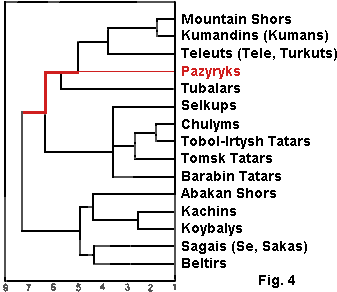 |
Fig. 8 Male skulls. Dendrogramm with taxonomycal weighting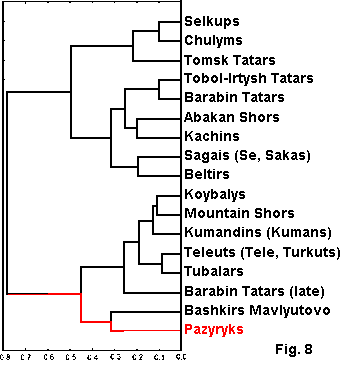 |
Summary
The modern populations of the Northern Altai anthropological type, to which belong the Northern Altaians, Teleuts, Mountain Shors, and also late time Barabin Tatars, are descendants of the Pazyryk culture carriers. The typical for them craniological complex was formed in the territory of the Altai Mountains as a result of a long mixture and leveling out the features of two main components of different origin: a brachicranial, with moderately expressed Mongoloid features and low, in the Mongoloid scale, face, and a dolichocranial Europeoid, with high and wide face. First of them is found in the territory of the Altai Mountains since the Eneolith Epoch (Lower Tytkesken -1 and Chimney caves), the second appears during the Early Bronze epoch as a result of migration of cattle breeding tribes, presumably from the Middle or Near Asia (Chikisheva T.A., 1996, p. 250-251; 2000á, p. 112). In its "purest" form the craniological complex typical for Pazyryks was preserved inTeleuts and late time Barabin Tatars. A similar craniotype also have Mavlütovo Bashkirs.
Between Pazyryks, Kulais, and modern populations of the Ob-Irtysh anthropological type, and also between the Kets is a common genetic component, with morphological specificity determined by a combination of brachicrania, moderately expressed Mongoloid features and low, in Mongoloid scale, face. It is this craniologicals complex that creates the molecular genetic affinity of the Pazyryks, Selkups and Kets, found by the analysis of the mitochondrial DNA. The Pazyryks, Selkups and Kets received this brachicranial low-faced Mongoloid component by independent processes. For the Southern Taiga population of the Western Siberia it was already typical during the Early Bronze epoch, Selkups inherited it from the Kulais (Bagashev A.N., 2000á, p. 36-37, 47). No craniological data supports a suggested migration of the Pazyryks to the taiga zone of the Western Siberia (Molodin V.I., 2000, p. 136, 138).
The original components in the anthropology of the modern Northern Altaian and Khakass populations not only have different densities, but they also have a different origin.
Alekseev V.P. Geography of human races. - Ì., 1974. - 352 p.
Alekseev V.P., Gohman I.I. Anthropology of the Asian part of the USSR. - Ì.,
1984. - 208 p.
Alekseev V.P., Gohman I.I., Tumen D. Brief sketch of Central Asia
paleoanthropology (Stone Age - epoch of early iron) // Archeology, ethnography
and anthropology of Mongolia. - Novosibirsk, 1987. - p. 208-241.
Bagashev A.N. Anthropological societies, their systematization and race-genetic
processes // Sketches of culturogenesis of Western Siberia peoples. V.4.
Race-genetics of indigenous population. - Tomsk, 1998. - p. 303-327.
Bagashev A.N.Paleoanthropology of Western Siberia: forest-steppe during epoch
of early iron. - Novosibirsk, 2000à. - 374 p.
Bagashev A.N. Formation of ancient and modern population of Western Siberia
from the data of craniology. Autoref. diss.: PhD Hist. - Ì., 2000á. - 51 p.
Bagashev A.N., Kim A.R. Paleoanthropology of Western Siberia origin of peoples
// Sketches of culturogenesis of Western Siberia peoples. V.4. Race-genetics of
indigenous population. - Tomsk, 1998. - p. 270-286.
Voevoda M.I., Romashchenko A.G., Sitnikova V.V., Shulgina E.O., Kobzev V.F.
Comparison of mitchondrial DNA polymorphism for Pazyryks and modern population
of Eurasia // Archeology, ethnography and anthropology of Eurasia. -
Novosibirsk, 2000. - V. 4. - p. 88-94.
Voevoda M.I., Sitnikova V.V., Romashchenko A.G. Race- and ethnospecific
features of Pazyryk culture mtDNA of Altai Mountains // Phenomenon of the Altay
mummies. - Novosibirsk, 2000. - Ch. 4.7. - p. 224-230.
Dremov V.A. Racial differentiation of Ugrian and Samodiy groups of Western
Siberia from the data of craniologiiy // Problems of anthropology of ancient
and modern population of the north of Eurasia. - Ë., 1984. - p. 106-132.
Dremov V.A. Craniometria // The Türks of
Chulym taiga. - Tomsk, 1991. - p. 166-199.
Dremov V.A., Kim A.R. Population of northern foothills of Altai // Sketches of
culturogenesis of Western Siberia peoples. Ò.4. Race-genetics of indigenous
population. - Tomsk, 1998. - p. 44-57.
Kim A.R. Anthropological structure and questions of an origin of indigenous
population of northern foothills of Altai. Autoref. diss.: PhD Hist. - Ì.,
1987. - 17 p.
Kim A.R. Barabin Tatars // Sketches of culturogenesis of Western Siberia
peoples. Ò.4. Race-genetics of indigenous population. - Tomsk, 1998. - p.
84-94.
Molodin V.I. Pazyryk culture: problems of ethnogenesis, ethnic history and
historical destinies // Archeology, ethnography and anthropology of Eurasia. -
Novosibirsk, 2000. - V. 4. - p. 131-142.
Molodin V.I., Romashchenko A.G., Voevoda M.I., Chikisheva T.A.
Multidisciplinary analysis of Pazyryk culture carriers (archeology,
anthropology, genetics) // Scythians and Sarmatians in 7-3 cc. BC (paleoecology,
anthropology and archeology). - Ì., 2000. - p. 59-66.
Tur S.S. About uraloidnom a component in anthropological structure of the
population of Altai Mountains of Scythian time // Results of studying of a
Scythian epoch of Altai and adjacent territories. - Barnaul, 1999. - p.
203-205.
Tur S.S. Anthropological structure of of Middle Katun population of Scythian
time (intra-group analysis) // Kirüshin J.F.,
Stepanova N.F., Tishkin A.A. Scythian epoch of Mountain Altai. P.2
Funeral-memorial complexes of Pazyryk culture. - Barnaul, 2002 (in print).
Chikisheva T.A. Question of formation of anthropological structure of the
Pazyryk culture population of Altai Mountains // Newest archeologic and
ethnographic discoveries in Siberia: Materials of 4th Annual final session of
Institute of archeology and ethnography of the Siberian Branch of the Russian
Academy of Science. December 1996. - Novosibirsk, 1996. - p. 249-252.
Chikisheva T.A. Anthropology of Pazyryk culture carriers // Phenomenon of
the Altai mummies. - Novosibirsk, 2000à. - Ch.1.3. - p. 35-49.
Chikisheva T.A. Question of origin of nomads of Altai Mountains of early iron
epoch according to anthropology // Archeology, ethnography and anthropology of
Eurasia. - Novosibirsk, 2000á. - Issue 4. - p. 107-121.
Chikisheva T.A., Pozdnyaks lD.V. Anthropology of the population of Altai
Mountains during Hun-Sarmatian time // Archeology, ethnography and anthropology
of Eurasia. - Novosibirsk, 2000. - V. 3. - p. 116-131.
Üsupov R.M. Craniology of the Bashkirs. -
L., 1989. - 200 p.